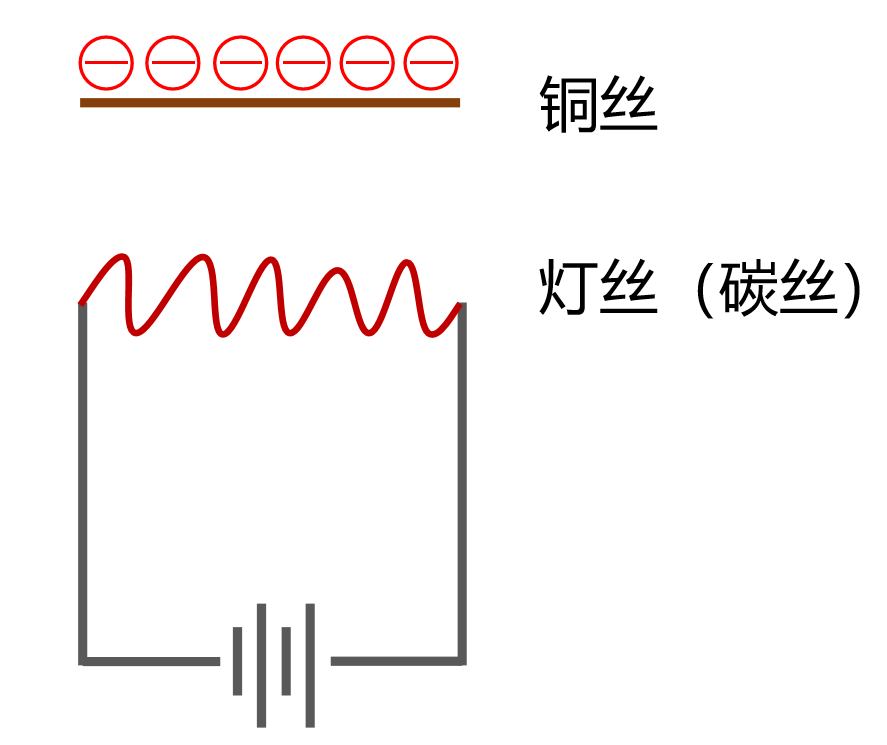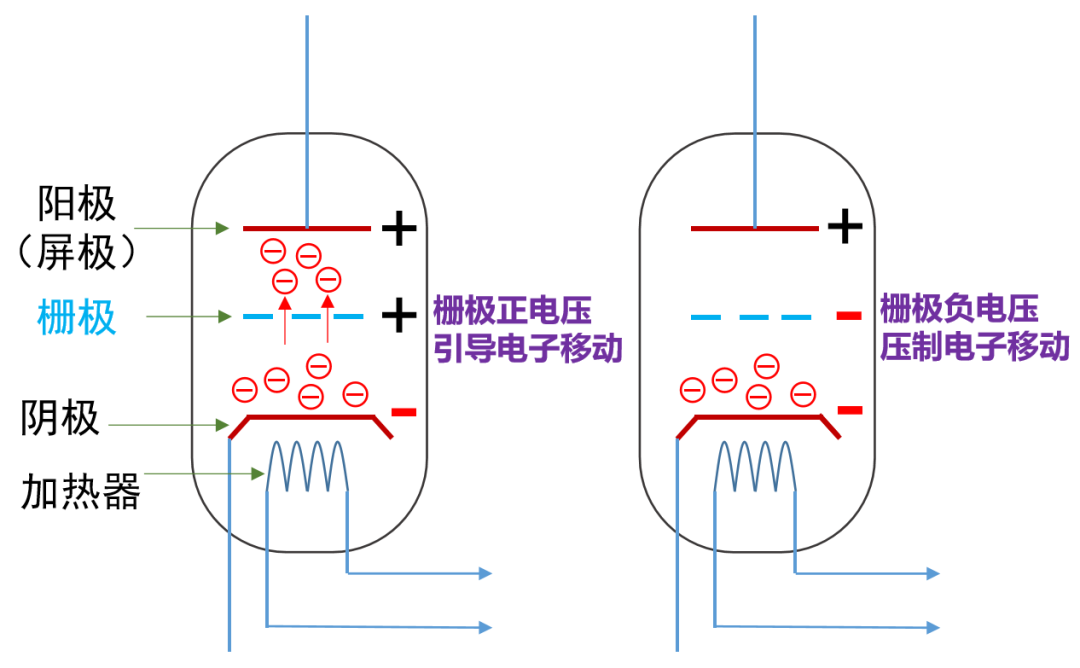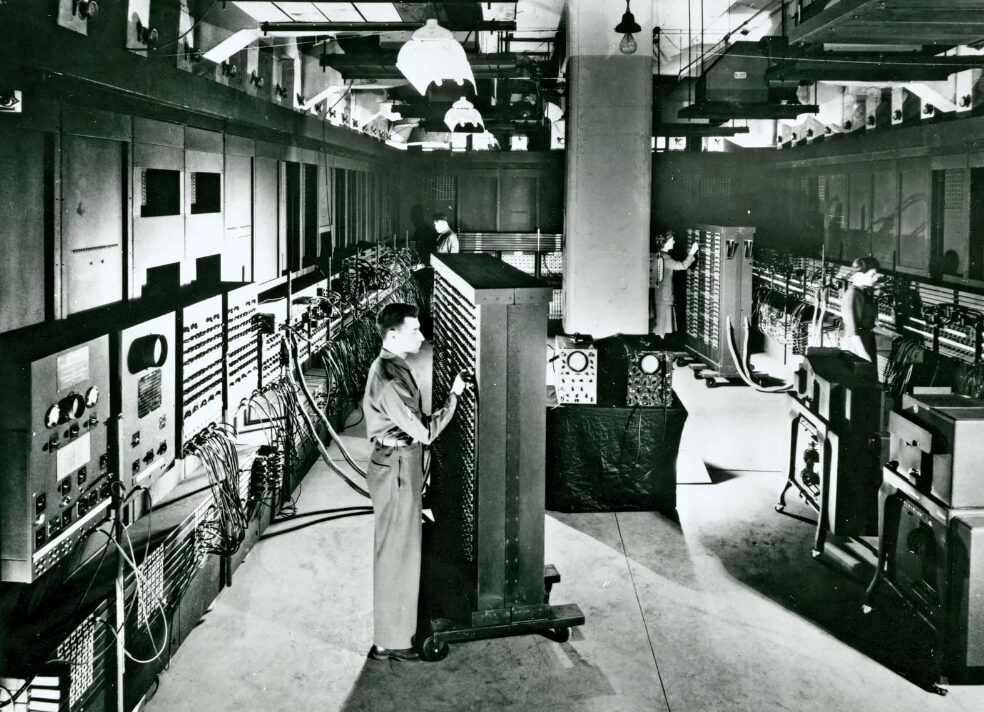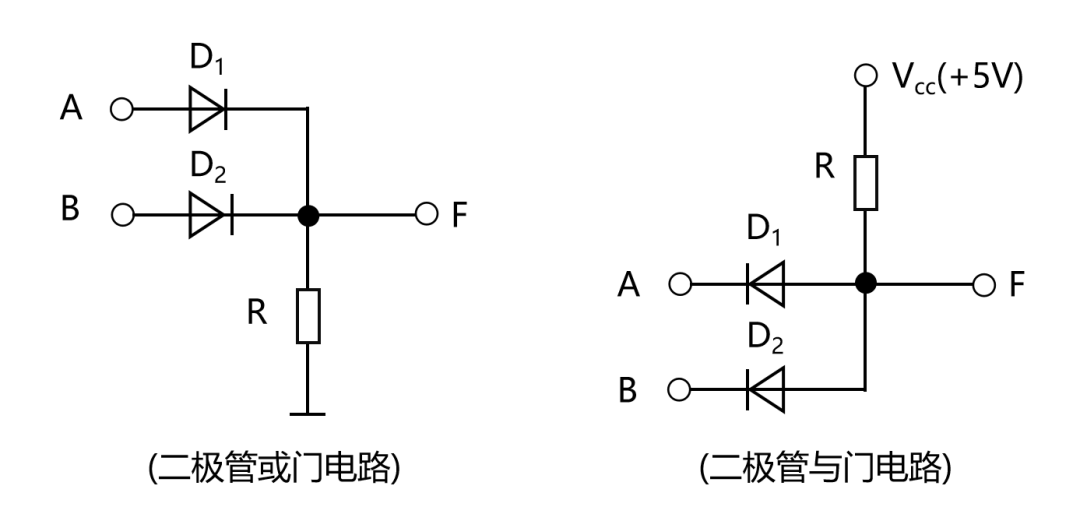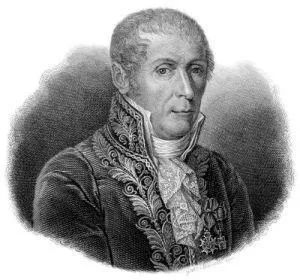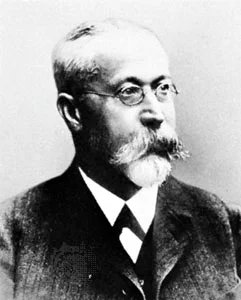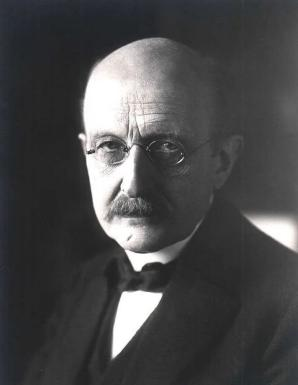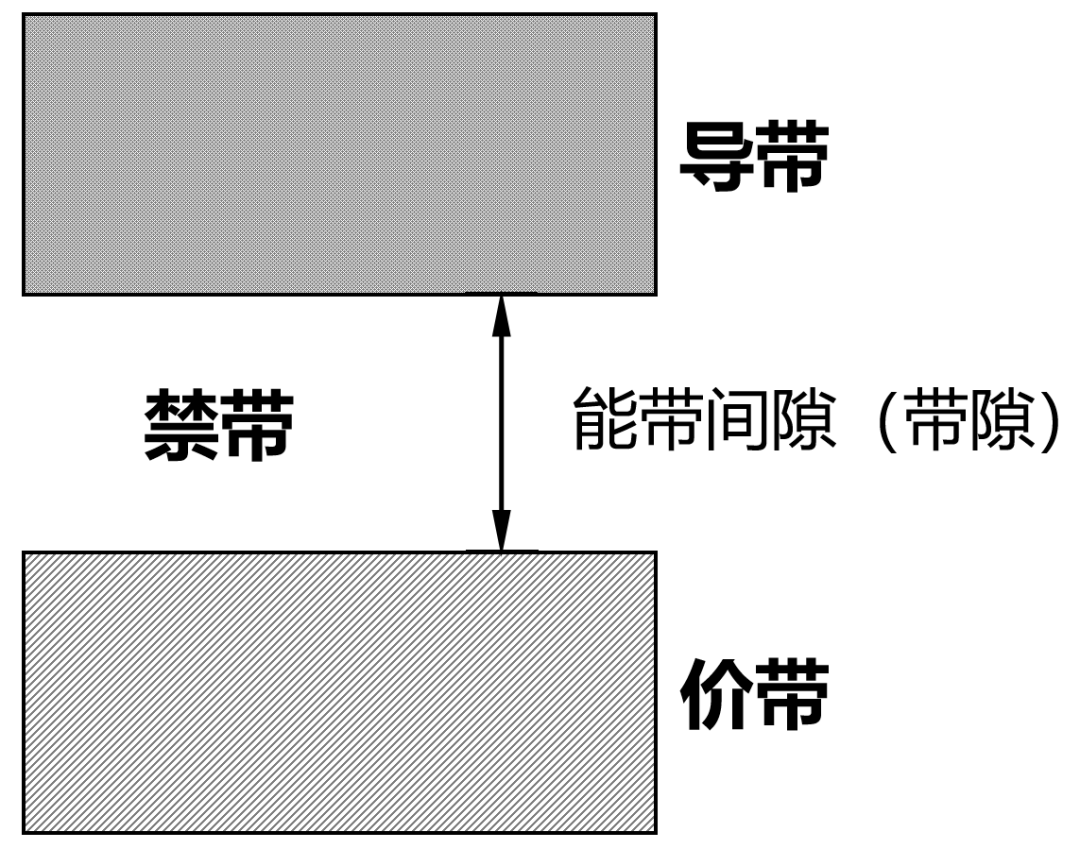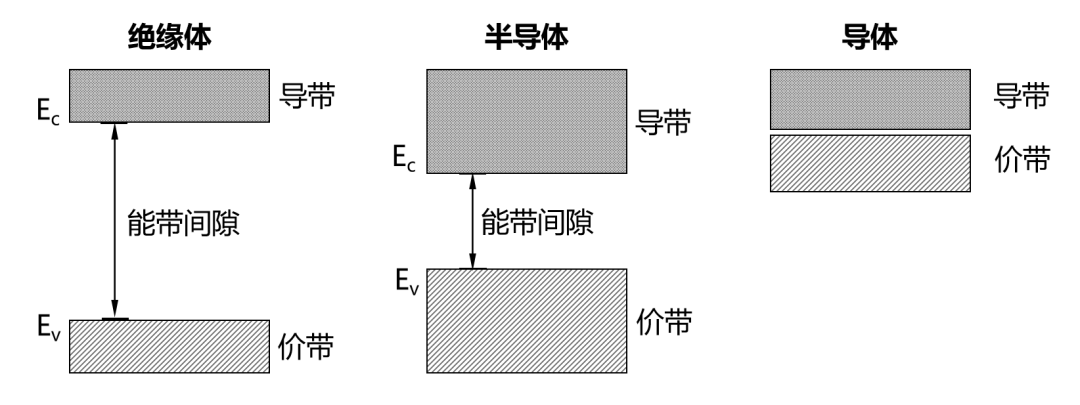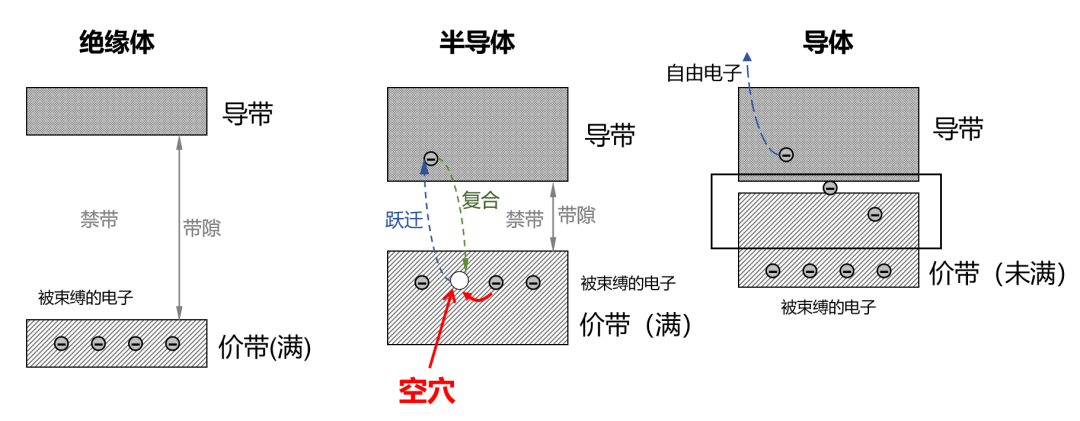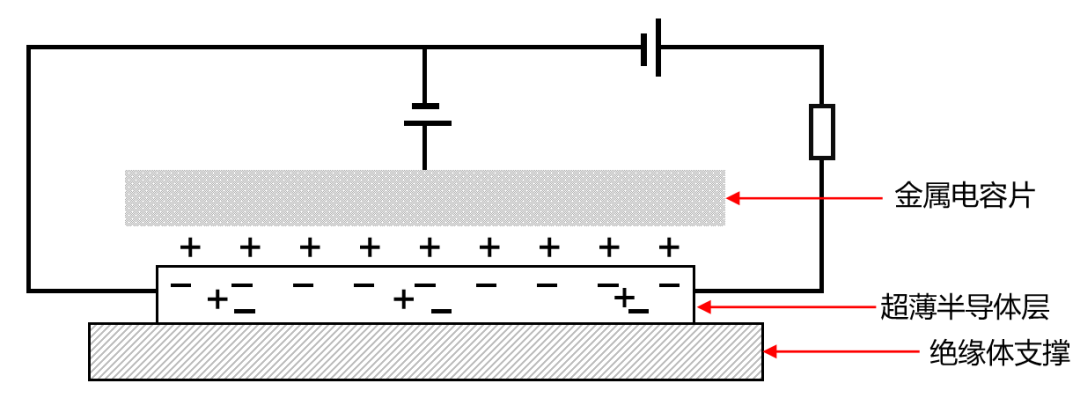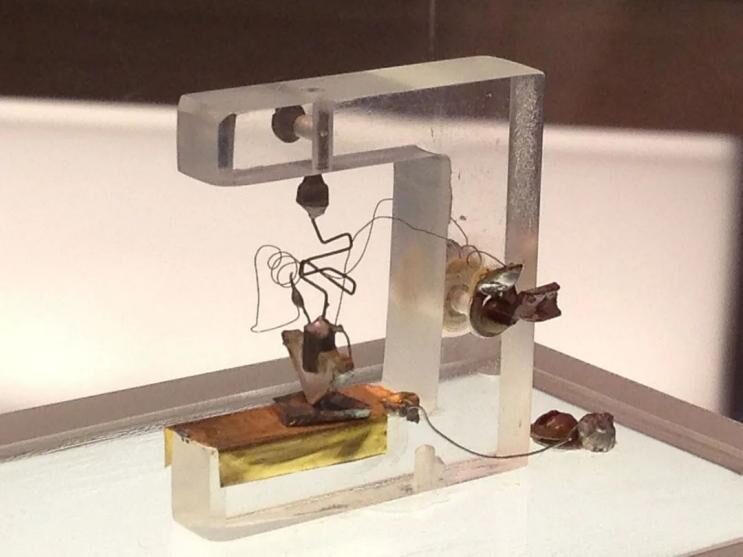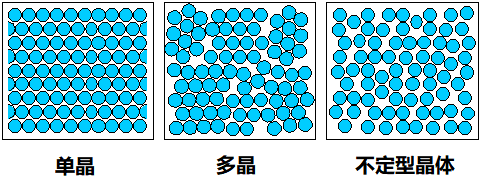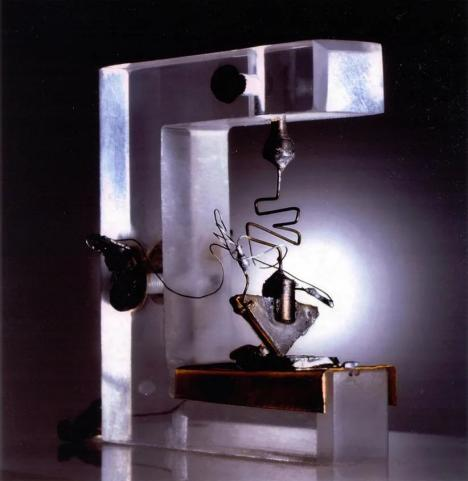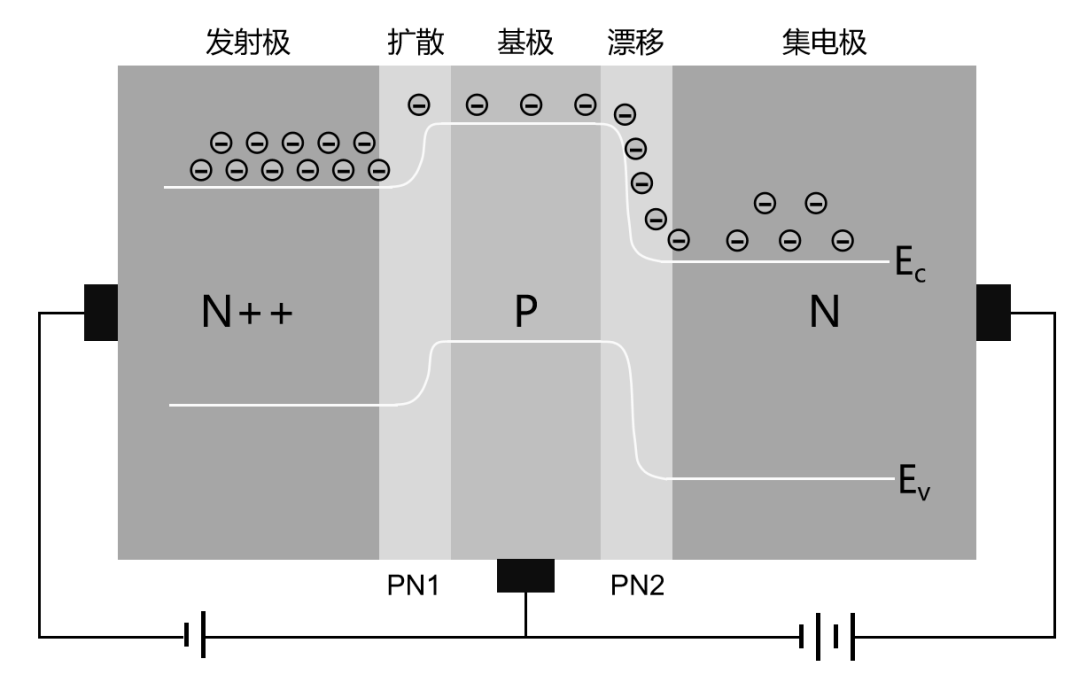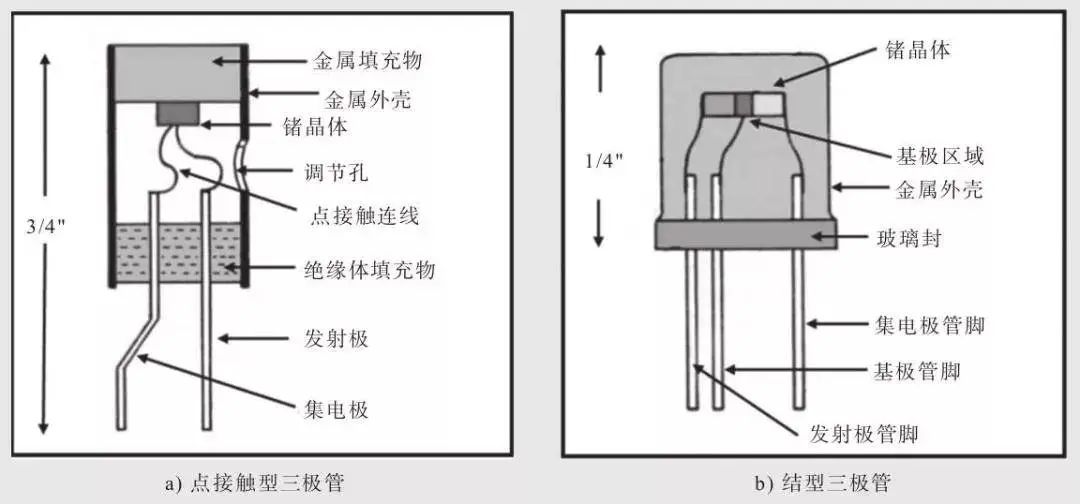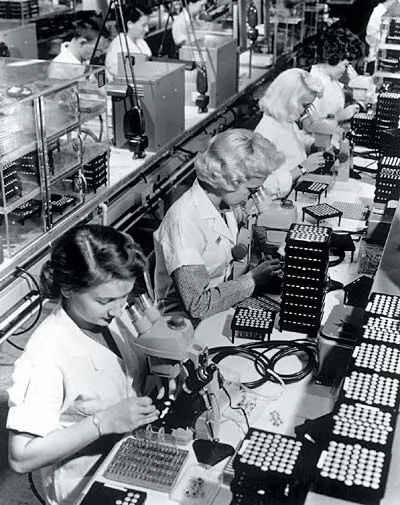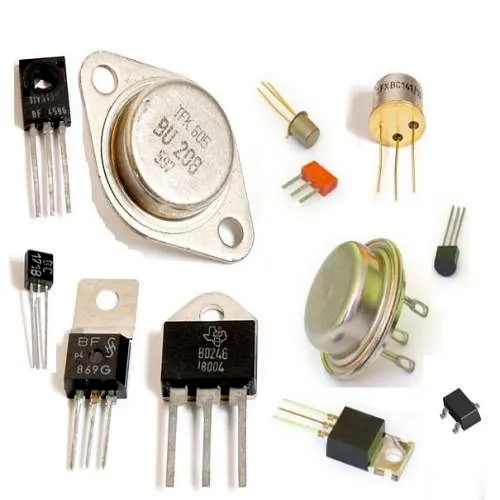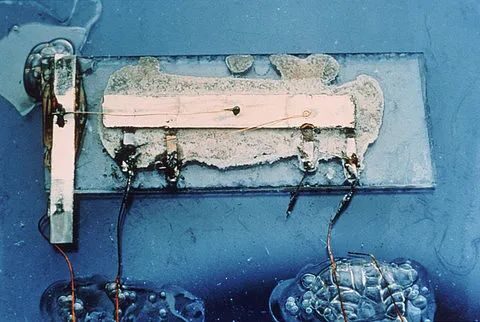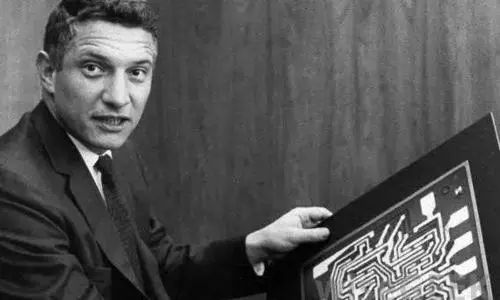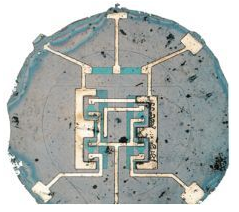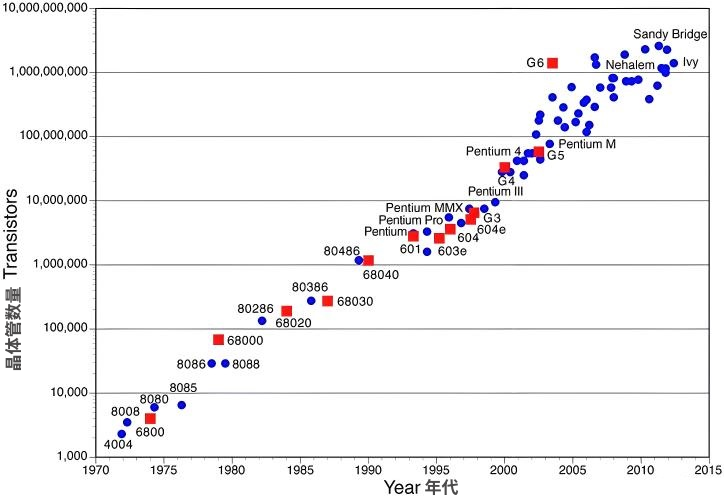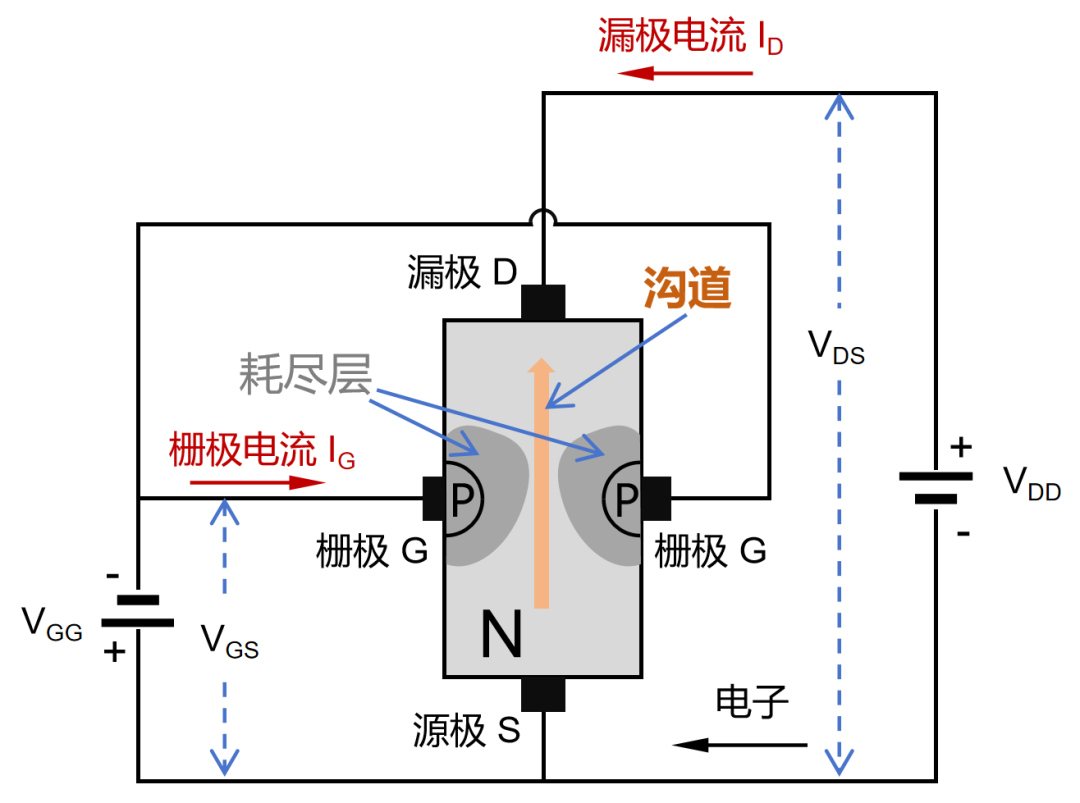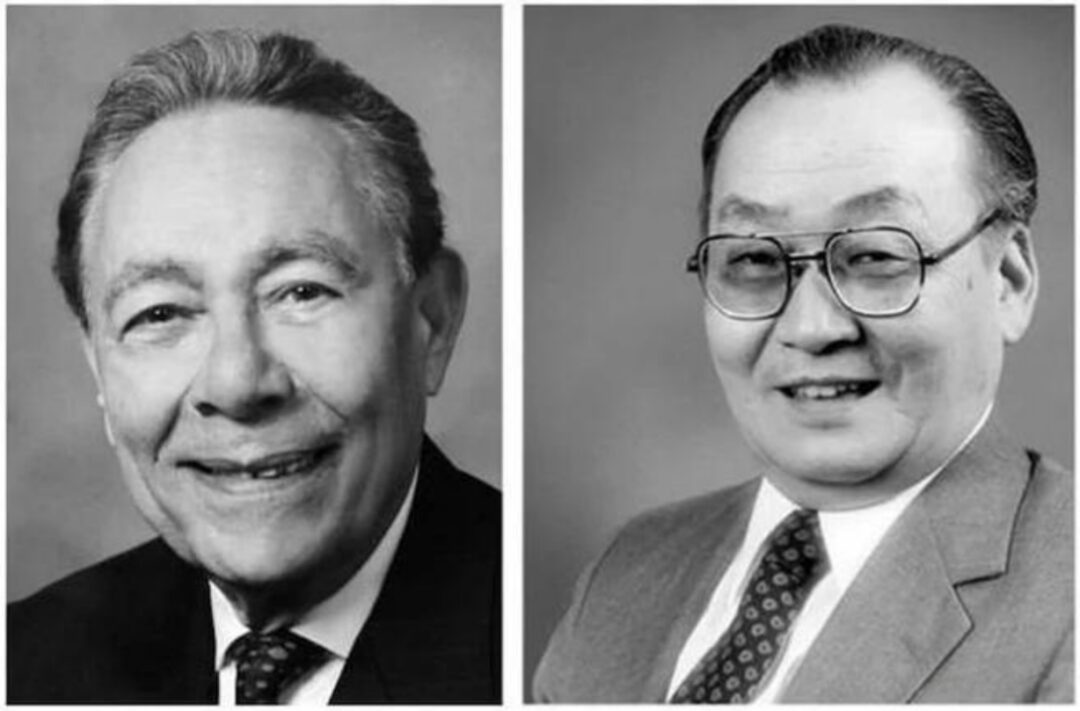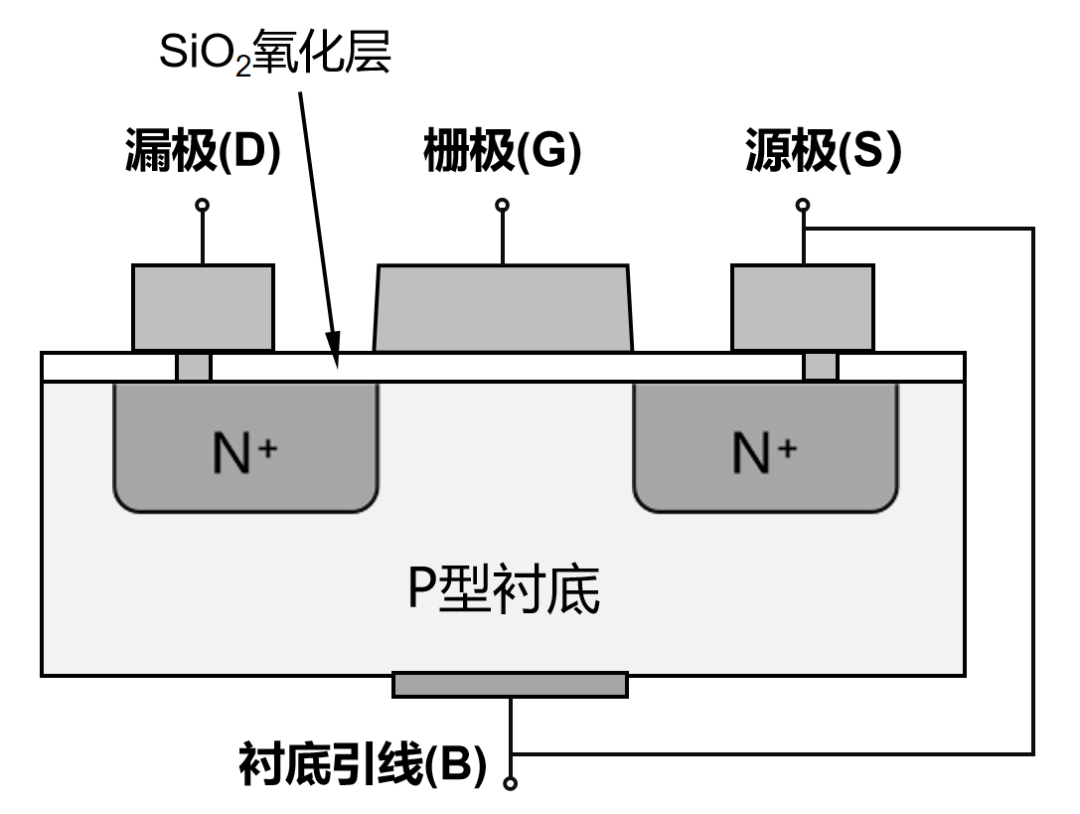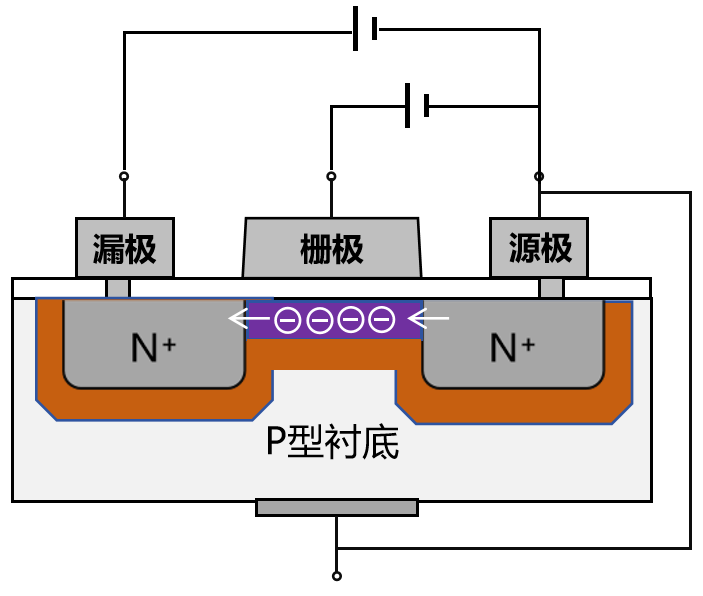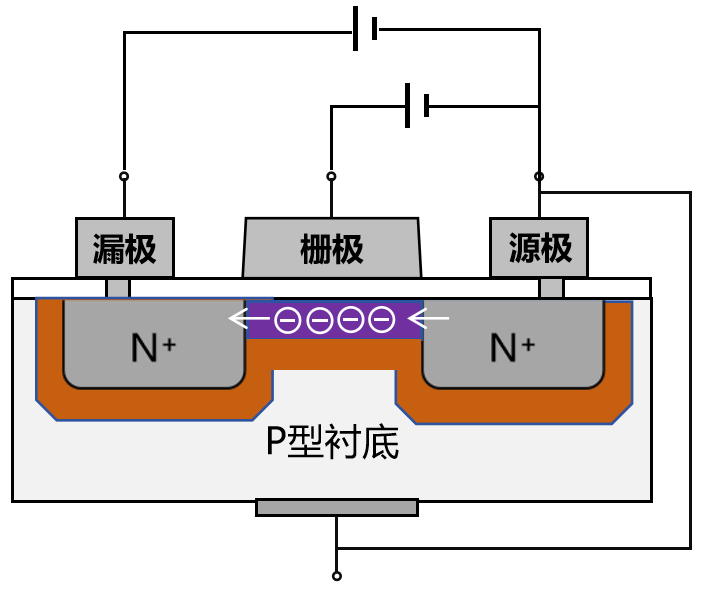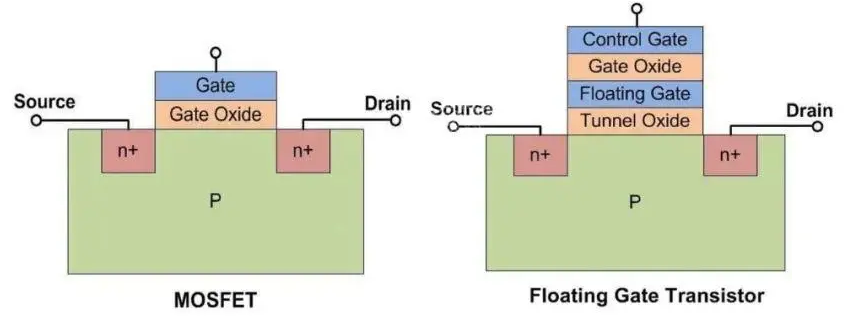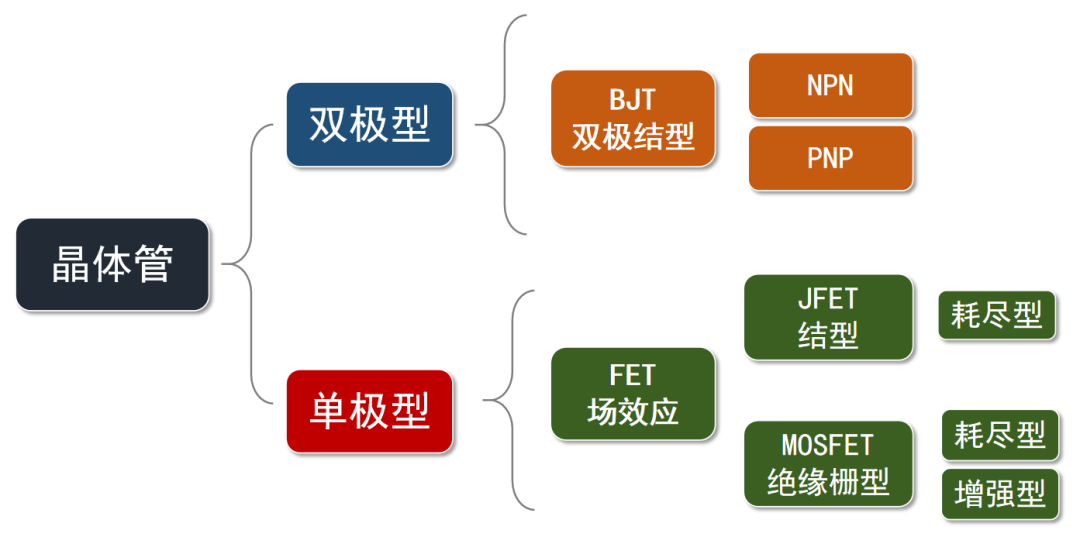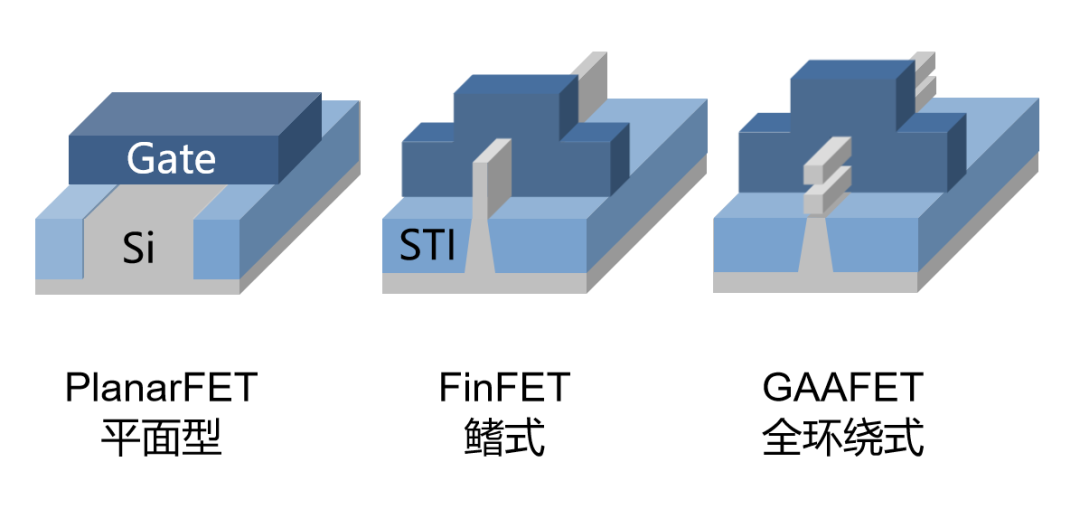In the previous article (A Beginner’s Guide to Semiconductor Chips), Xiaozhao introduced some basic knowledge about semiconductor chips.
In today’s article, we will continue discussing the process of chip creation—from vacuum tubes, transistors to integrated circuits, from BJT, MOSFET to CMOS, how chips have developed and how they actually work.
█ Vacuum Tubes (Electron Tubes)
In 1883, the famous inventor Thomas Edison observed a strange phenomenon during an experiment.
At that time, he was testing the lifespan of a filament (carbon filament). Next to the filament, he placed a copper wire, but the copper wire was not connected to any electrode. In other words, the copper wire was not powered.
When the carbon filament was powered, it began to glow and heat up. After a while, Edison disconnected the power supply. He inadvertently discovered that a current was generated in the copper wire as well.
Edison had no way to explain the reason for this phenomenon, but as a savvy “businessman,” the first thing he thought of was to apply for a patent for this discovery. He also named this phenomenon the “Edison Effect.”
Now we know that the essence of the “Edison Effect” is thermionic emission. In other words, when the filament is heated, the electrons on its surface become active and “escape,” resulting in a current being captured by the copper wire.
After Edison applied for the patent, he did not think of any practical use for this effect and thus shelved it.
In 1884, British physicist John Ambrose Fleming visited the United States and met Edison. Edison demonstrated the Edison Effect to Fleming, leaving a deep impression on him.

Fleming
It was not until many years later that Fleming truly utilized this effect.
In 1901, Guglielmo Marconi, the inventor of the radio, initiated long-distance radio communication experiments across the Atlantic. Fleming joined this experiment to help study how to enhance the reception of radio signals.
In simple terms, it involved researching how to detect signals at the receiving end, amplify the signals, and ensure they could be perfectly interpreted.
Everyone understands signal amplification, but what is signal detection?
Signal detection is essentially signal filtering. The signals received by the antenna are very chaotic, containing all sorts of signals. The signals we actually need (signals of a specified frequency) need to be “filtered” out from this chaos, which is what detection is.
To achieve detection, unidirectional conductivity (one-way conduction) is key.
Radio electromagnetic waves oscillate at high frequencies, reaching hundreds of thousands of times per second. The induced current generated by radio waves also changes continuously with “positive, negative, positive, negative”. If we use this current to drive a headphone, one positive and one negative would equal zero, and the headphone would not be able to accurately recognize the signal.
By adopting unidirectional conductivity, the negative half of the sine wave is eliminated, leaving only the positive, and the current direction becomes consistent. After filtering out the high frequency, the headphone can easily sense the changes in current.

By removing the negative half, the current direction becomes consistent, making it easier to interpret.
To detect signals, Fleming thought of the “Edison Effect”—could a new type of detector be designed based on the electron flow of the Edison Effect?
Thus, in 1904, the world’s first vacuum electron diode was born under Fleming’s hands. At that time, this diode was also called the “Fleming Valve”. (Vacuum tube, also known as an electron tube, is sometimes referred to as a “bulb tube.”)

The diode invented by Fleming
Fleming’s diode has a very simple structure, consisting of a vacuum glass bulb with two electrodes: a cathode (Cathode) that emits electrons when heated (cathode rays), and an anode (Anode) that receives electrons.
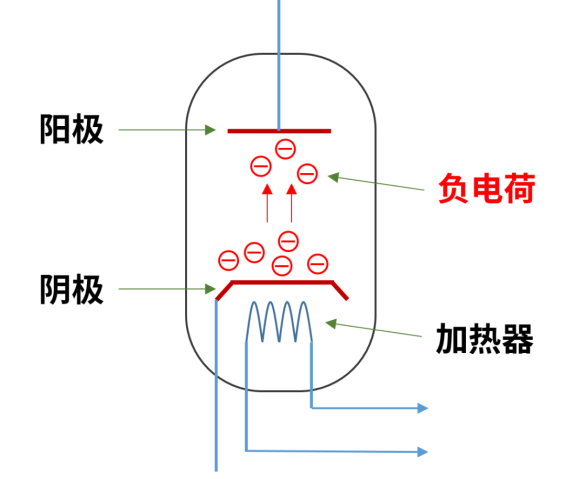
旁热式二极管
The reason for creating a vacuum inside the glass tube is to prevent gas ionization, which would affect normal electron flow and destroy the characteristic curve. (Creating a vacuum also effectively reduces filament oxidation loss.)
The emergence of diodes solved the needs for detection and rectification, marking a significant breakthrough. However, there was still room for improvement.
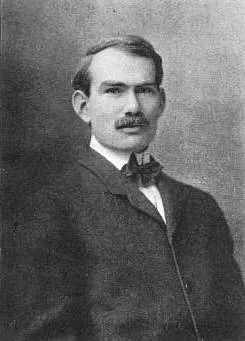
De Forest
In 1906, American scientist De Forest Lee ingeniously added a grid (“grid”) to the vacuum diode, inventing the vacuum triode.

The triode invented by De Forest
After adding the grid, when the voltage on the grid is positive, it will attract more electrons emitted from the cathode. Most electrons will pass through the grid to the anode, greatly increasing the current on the anode.
If the voltage on the grid is negative, the electrons on the cathode will lack the motivation to move towards the grid and will not reach the anode.
A small change in current at the grid can cause a large change in current at the anode. Moreover, the waveform of the change is completely consistent with the grid current. Therefore, the triode has the effect of amplifying signals.
Initially, triodes were single-grid, later becoming double-grid structures, and eventually evolving into fully enclosed grid structures.
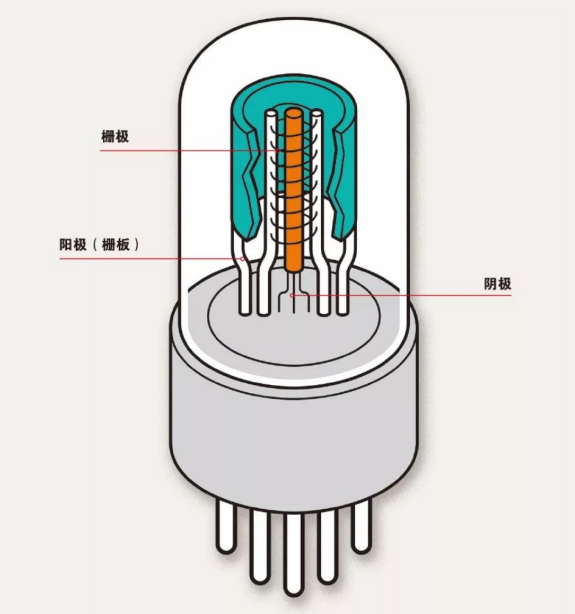
Surrounding Grid
The birth of the vacuum triode was a milestone event in the field of electronics.
This small component truly realized the control of electricity using electricity (previously, mechanical switches were used to control electricity, which had issues such as low frequency, short lifespan, and fragility), enabling “small current” to control “large current.”
It integrated detection, amplification, and oscillation functions, laying the foundation for the development of electronic technology.
Based on it, we now have increasingly powerful radio stations, radios, phonographs, movies, broadcasting, radar, and walkie-talkies. The widespread adoption of these products has changed people’s daily lives and promoted social progress.

Vacuum Tubes
In 1919, Schottky proposed the idea of adding a screen grid between the grid and the anode. This idea was realized by British engineer Langdell in 1926. This led to the later development of the tetrode. Later, Dutch scientists Holst and Tylegen invented the pentode.
In the 1940s, computer technology research reached a climax. People discovered that the unidirectional conduction characteristics of vacuum tubes could be used to design some logic circuits (such as AND gate circuits, OR gate circuits).
As a result, they began to introduce vacuum tubes into the field of computers. At that time, almost all electronic computers, including ENIAC (which used over 18,000 vacuum tubes), were manufactured based on vacuum tubes.
Here we briefly talk about gate circuits.
When we study the basics of computers, we definitely learn about basic logical operations, such as AND, OR, NOT, XOR, NOR, NAND, etc.
Computers only recognize 0 and 1. Their calculations are based on these logical operation rules.
For example, 2 + 1 is expressed in binary as 0010 + 0001, performing an “XOR operation” results in 0011, which is 3.
The circuits that implement these logical gate functions are known as logic gate circuits. The unidirectional conducting vacuum tubes (electron tubes) can be configured into various logic gate circuits.
For example, the following “OR gate circuit” and “AND gate circuit.”
A and B are inputs, F is the output
While electronic tubes were rapidly developing and being applied, people gradually discovered that this product had some drawbacks:
On one hand, vacuum tubes are prone to breakage and have a high failure rate; on the other hand, vacuum tubes require heating, wasting a lot of energy through heat and resulting in very high power consumption.
Thus, people began to ponder—was there a better way to achieve circuit detection, rectification, and signal amplification?
Of course, there was a way. At this time, a great material was about to emerge—semiconductors.
-
The Emergence of Semiconductors
We will continue to move forward in time, back to the 18th century.
In 1782, the famous Italian physicist Alessandro Volta summarized through experiments that solid materials can be roughly divided into three types:
The first type, such as metals like gold, silver, copper, and iron, conducts electricity easily and is called conductors;
The second type, such as wood, glass, ceramics, and mica, does not conduct electricity easily and is called insulators;
The third type, which is between conductors and insulators, can slowly discharge electricity.
The peculiar property of this third type of material was named by Volta as “Semiconducting Nature,” which is the first time in human history that the term “semiconductor” appeared.
Later, several scientists inadvertently discovered some phenomena related to semiconductor properties. For example:
In 1833, Michael Faraday discovered that the resistance of silver sulfide decreases when the temperature rises (the thermal sensitivity of semiconductors).
In 1839, French scientist Alexandre Edmond Becquerel discovered that light exposure can create a potential difference across certain materials (the photovoltaic effect of semiconductors).
In 1873, Willoughby Smith discovered that the conductivity of selenium increases under light exposure (the photoconductive effect of semiconductors).
These phenomena were not explained at the time and did not attract much attention.
In 1874, German scientist Karl Ferdinand Braun discovered the unidirectional conduction characteristics of natural mineral ores (metal sulfides). This was a significant milestone.
In 1906, American engineer Greenleaf Whittier Pickard invented the famous crystal detector based on chalcopyrite crystals, also known as the “cat whisker detector” (the detector has a probe that resembles a cat’s whisker, hence the name).
The crystal detector was the first semiconductor device created by humans. Its emergence was a “small trial” of semiconductor materials.
Although it had some defects (poor quality control, unstable operation due to low purity of the ore), it significantly promoted the development of electronic technology. At that time, radio receivers based on crystal detectors facilitated the popularization of broadcasting and radio.
-
The Emergence of Band Theory
While people were using crystal detectors, they could never understand how they worked. In the following 30 years, scientists repeatedly pondered—why do semiconductor materials exist? Why can semiconductor materials achieve unidirectional conduction?
In the early days, many people even doubted whether semiconductor materials really existed. The famous physicist Pauli once stated: “People should not study semiconductors; it is a dirty mess, and who knows if semiconductors exist.”
Later, with the birth and development of quantum mechanics, theoretical research on semiconductors finally made breakthroughs.
In 1928, German physicist and one of the founders of quantum mechanics, Max Karl Ernst Ludwig Planck, proposed the band theory of solids while applying quantum mechanics to study the conductivity of metals.
The father of quantum theory, Planck
He believed that under the influence of an external electric field, the conduction of semiconductors can be divided into conduction involving “holes” (P-type conduction) and conduction involving electrons (N-type conduction). Many of the peculiar properties of semiconductors are determined by both “holes” and electrons.
Later, the band theory was further refined, systematically explaining the essential differences between conductors, insulators, and semiconductors.
Let’s briefly understand band theory.
As we learned in high school physics, objects are made up of molecules and atoms, and the outer layer of atoms consists of electrons.
In solid objects, the atoms are closely packed together, causing the electrons to mix. Quantum mechanics suggests that electrons cannot remain in one orbit, as they would “collide”. Thus, the orbit splits into several finer orbits.
In quantum mechanics, these fine orbits are called energy levels, and multiple fine orbits that crowd together form a wide band, called an energy band.
In two energy bands, the one below is called the valence band, and the one above is called the conduction band, with a forbidden band in between. The distance between the valence band and the conduction band is called the band gap (energy gap).
Electrons moving in the wide band manifest as conductivity on a macroscopic level. If there are too many electrons occupying the orbit, they cannot move, resulting in non-conductivity.
Some filled and empty orbits are very close together, allowing electrons to easily jump from filled to empty orbits, resulting in free movement, which defines conductors.
When the two orbits are too far apart, the gap is too large, and electrons cannot jump across, leading to non-conductivity. However, if external energy is supplied, this state can be changed.
If the band gap is within 5 electron volts (5eV), adding energy to the electrons allows them to jump across and move freely, which is characteristic of semiconductors. (Silicon has a band gap of about 1.12eV, while germanium is about 0.67eV.)
If the band gap exceeds 5 electron volts (5eV), electrons cannot normally cross it and are classified as insulators. (If a very high external energy is applied, it can force electrons to jump across. For example, air is an insulator, but high-voltage electricity can break down air and create a current.)
It is worth mentioning that the “wide bandgap semiconductors” we often hear about include third-generation semiconductor materials such as silicon carbide (SiC), gallium nitride (GaN), zinc oxide (ZnO), diamond, and aluminum nitride (AlN).
They have advantages such as a large bandgap (>2.2eV), high breakdown electric field, high thermal conductivity, strong radiation resistance, high luminous efficiency, and high frequency, making them suitable for high temperature, high frequency, radiation-resistant, and high-power devices, which are the current focus of industry development.
Earlier, we mentioned electrons and holes. There are two types of charge carriers in semiconductors: free electrons and holes. Free electrons are familiar to everyone, but what are holes?
Holes are also known as electron holes.
At room temperature, due to thermal motion, a few electrons with higher energy at the top of the valence band may cross the band gap and move to the conduction band, becoming “free electrons.”
When electrons escape, they leave behind a “hole”. The remaining electrons that have not moved up can enter this “hole,” generating current. Note that holes themselves do not move, but the process of electrons “filling the hole” creates the effect of positive charge flowing, so they are also regarded as charge carriers.
In 1931, British physicist Charles Thomson Rees Wilson proposed a physical model for semiconductors based on band theory.
In 1939, Soviet physicist A.S. Davydov, British physicist Nevill Francis Mott, and German physicist Walter Hermann Schottky made significant contributions to the basic theory of semiconductors. Davydov was the first to recognize the role of minority carriers in semiconductors, while Schottky and Mott proposed the famous “diffusion theory.”
Based on the contributions of these great figures, the foundation of semiconductor theory was gradually established.
-
The Birth of the Transistor
After the crystal detector was invented, scientists discovered that the performance of this detector was greatly related to the purity of the ore. The higher the purity of the ore, the better the performance of the detector.
Therefore, many scientists conducted purification research on ore materials (such as lead sulfide, copper sulfide, copper oxide, etc.), continuously improving purification processes.
In the 1930s, scientists at Bell Labs, led by Russell Shoemaker Ohl, proposed that detectors made from purified crystal materials would completely replace electron diodes. (At that time, electron tubes were in absolute market dominance.)
Russell Ohl, also known as the father of modern solar cells
After testing over 100 materials, he concluded that silicon crystals were the most ideal material for making detectors. To validate his conclusion, he, with the help of his colleague Jack Scaff, extracted a high-purity silicon crystal melt.
Since Bell Labs did not have the ability to cut silicon crystals, Ohl sent this melt to a jewelry store to be cut into different sizes of crystal samples.
Unexpectedly, one of the samples exhibited a positive pole (positive) on one end and a negative pole (negative) on the other end when exposed to light. Ohl named them the P region and N region, respectively. Thus, Ohl invented the world’s first semiconductor P-N junction (P–N Junction).
During World War II, AT&T’s Western Electric Company manufactured a batch of silicon crystal diodes based on purified semiconductor crystals. These diodes were compact, had a low failure rate, and significantly improved the performance and reliability of the Allies’ radar systems.
Ohl’s invention of the P-N junction and the excellent performance of silicon crystal diodes solidified Bell Labs’ determination to develop transistor technology.
In 1945, after communicating with Russell Ohl, William Shockley at Bell Labs drew energy band diagrams for P-type and N-type semiconductors based on band theory and proposed the “field effect concept.”
Shockley’s field effect concept
He hypothesized that if the internal charges of silicon chips could freely move, and if the chip was thin enough, under the influence of applied voltage, electrons or holes would emerge on the surface of the silicon chip, greatly enhancing its conductivity, thus achieving current amplification.
Based on this hypothesis, on December 23, 1947, John Bardeen and Walter Brattain at Bell Labs created the world’s first semiconductor transistor amplifier. This was the strange and simple-looking device below:
The world’s first transistor (based on germanium semiconductor)
According to experimental records, this transistor could achieve “voltage gain of 100, power gain of 40, current loss of 1/2.5…” and performed exceptionally well.
When naming it, Bardeen and Brattain believed that the reason this device could amplify signals was due to its resistance transformation characteristics, where the signal moved from “low resistance input” to “high resistance output.” Thus, they named it trans-resistor. Later, it was abbreviated to transistor.
Years later, the famous Chinese scientist Qian Xuesen established its Chinese name as: 晶体管.
To summarize, the property of semiconductors is a special conductivity (affected by external factors). Materials that exhibit semiconductor properties are called semiconductor materials. Silicon and germanium are typical semiconductor materials.
On a microscopic level, substances that are arranged in a specific pattern are called crystals. Silicon crystals can exist in forms such as single crystal, polycrystalline, and amorphous.
The crystal structure determines the energy band structure, and the energy band structure determines the electrical properties. Therefore, silicon (germanium) crystals as semiconductor materials have significant application value.
Diodes, transistors, and tetrodes are named based on their functions. Vacuum tubes (electron tubes) and transistors (silicon transistors, germanium transistors) are named based on their principles.
The transistor invented by Bardeen and Brattain should actually be called point-contact transistor. As can be seen from the diagram below, this design is overly simplistic. Although it achieved amplification, its structure was fragile, sensitive to external vibrations, and difficult to manufacture, making it unsuitable for commercial application.
Shockley recognized this flaw and began to research a new transistor design.
On January 23, 1948, after more than a month of effort, Shockley proposed a new transistor model with a three-layer structure, naming it junction transistor.
Shockley’s junction transistor design
Helping Shockley complete the final product was Morgan Sparks and Gordon Kidd Teal.
It is particularly important to mention Gordon Teal.
He discovered that replacing polycrystalline with single crystal could lead to significant performance improvements. Moreover, he was the one who found that the Czochralski method could be used for purifying metal single crystals. This method has been continuously used and is the primary method for producing single crystals in the semiconductor industry.
The birth of the transistor has extremely important significance for the development of human technology.
It possesses the capabilities of vacuum tubes while overcoming all the drawbacks of vacuum tubes, such as large size, high energy consumption, small amplification factor, short lifespan, and high cost. From the moment it was born, it was destined to replace vacuum tubes comprehensively.
Workers producing transistors
In the field of wireless communication, transistors, like vacuum tubes, can achieve the emission, detection, and amplification of electromagnetic waves. In the digital circuit field, transistors can also more conveniently realize logic circuits. It laid a solid foundation for the rapid development of the electronics industry.
The ever-expanding family of transistors
The emergence of transistors made circuit miniaturization possible.
In 1952, the famous scientist Geoffrey Dummer from the British Royal Radar Establishment pointed out at a conference:
“With the advent of transistors and comprehensive research on semiconductors, it now seems conceivable that future electronic devices will be solid components without connecting wires.”
In August 1958, a new employee at Texas Instruments, Kilby, discovered that a tiny microcircuit composed of many components could be made on a single chip. In other words, different electronic components (such as resistors, capacitors, diodes, and transistors) could be made on a silicon wafer and then connected with fine wires.
Not long after, on September 12, Kilby successfully manufactured the world’s first integrated circuit (Integrated Circuit) based on his idea, which measured 7/16 inches long and 1/16 inches wide.
This circuit was a single transistor oscillator with RC feedback, and it was very simply glued onto a glass slide. The components of the circuit were connected with random fine wires.
While Kilby was inventing the integrated circuit, another person also made breakthroughs in this field. This person was Robert Noyce of Fairchild Semiconductor (who later founded Intel).
Fairchild was a company founded by the “Traitorous Eight” in Silicon Valley (see: The Legend of Fairchild), possessing strong capabilities in semiconductor technology.
One of the “Traitorous Eight,” Jean Hoerni, invented the very important planar process.
This process involves adding a layer of silicon oxide as an insulating layer on the silicon wafer. Then, holes are drilled in this insulating silicon oxide layer, and aluminum thin films are used to connect the devices made with silicon diffusion technology.
The emergence of the planar process enabled Fairchild to manufacture high-performance silicon crystal transistors of very small sizes, making interconnection between components in integrated circuits possible.
On January 23, 1959, Noyce wrote in his work notes:
“By making various components on the same silicon wafer and connecting them with the planar process, multifunctional electronic circuits can be manufactured. This technology can reduce the size of circuits, lighten weight, and lower costs.”
Noyce was very regretful when he learned that Kilby had submitted the patent for the integrated circuit, believing he was one step behind. However, he soon discovered that Kilby’s invention actually had defects.
Kilby’s integrated circuit used flying wire connections, which could not be mass-produced and lacked practical value.
To create a substrate for all electronic devices’ circuits and components, and then etch them onto a silicon wafer. Once the silicon wafer is etched, it contains all the circuits, which can be directly used for product assembly.Additionally, using metal deposition methods can replace thermal soldering wires, completely eliminating flying wires.
Fairchild’s silicon crystal integrated circuit
On July 30, 1959, Noyce applied for a patent based on his idea: “Semiconductor Device—Wire Structure”.
Strictly speaking, Noyce’s invention is closer to the modern definition of integrated circuits. Noyce’s design is based on silicon substrate planar processes, while Kilby’s design is based on germanium substrate diffusion processes. Noyce’s circuits, made with Fairchild’s silicon process advantages, were indeed more advanced than Kilby’s.
In 1966, the court ultimately ruled that the invention rights for the concept of integrated circuits (hybrid integrated circuits) were granted to Kilby, while the invention rights for the integrated circuits packaged onto a chip (true integrated circuits) and the manufacturing process were granted to Noyce.
Kilby is hailed as the “inventor of the first integrated circuit,” while Noyce is recognized as the person who “proposed a theory for industrially viable integrated circuits.”
In March 1960, Texas Instruments officially launched the world’s first commercial integrated circuit product—the 502 silicon bistable multivibrator, priced at $450.
After the emergence of integrated circuits, they were first applied in the military sector (at that time, it was the most sensitive period of the Cold War).
In 1961, the U.S. Air Force launched the first computer driven by integrated circuits. In 1962, the U.S. also used integrated circuits in the guidance system of the Minuteman ballistic missile.
Later, the famous Apollo moon landing program purchased over a million integrated circuits, making Texas Instruments and Fairchild earn a fortune.
The success in the military market led to the expansion of the civilian market.In 1964, Zenith Corporation used integrated circuits in hearing aids, marking the first application of integrated circuits in the civilian sector.
The story afterwards is familiar to everyone. With the joint efforts of materials, processes, and manufacturing techniques, the number of transistors in integrated circuits has continuously increased, performance has consistently improved, and costs have gradually decreased, leading us into the era of Moore’s Law.
Moore’s Law: The number of transistors that can be accommodated on an integrated circuit doubles approximately every 18 months, and performance also doubles.
Based on the development of integrated circuits, large-scale and ultra-large-scale integrated circuits have paved the way for the emergence of semiconductor storage and microprocessors.
In 1970, Intel launched the world’s first DRAM (Dynamic Random Access Memory) integrated circuit, the 1103. The following year, they introduced the world’s first programmable computing chip, including an arithmetic unit and a controller—the Intel 4004.
The golden age of IT technology officially began.
█ Evolution of Transistors
Let’s turn back and discuss transistors.
Since the invention of transistors, their forms have undergone several significant changes. In summary, they have transitioned from bipolar to unipolar. In terms of unipolar types, they have evolved from FET to MOSFET. From a structural perspective, they have evolved from PlanarFET to FinFET, and then to GAAFET.
There are many abbreviations, and they are quite similar, which can be confusing. Please be patient as we go through them one by one.
The junction transistor invented by Shockley in 1948, which uses both holes and electrons as charge carriers, is called a bipolar junction transistor (Bipolar Junction Transistor, BJT).
BJT transistors have two structural forms: NPN and PNP.
We can see that the BJT transistor is made on a semiconductor substrate, creating two PN junctions that are very close together. The two PN junctions divide the semiconductor into three parts: the middle part is the base, and the two sides are the emitter and collector.
The working principle of BJT transistors is relatively complex, and they are rarely used now, so I won’t go into detail due to space limitations. Essentially, the main function of this transistor is to allow a small change in current at the base to produce a large change in current at the collector, thus amplifying the signal.
Earlier, Xiaozhao mentioned logic circuits. Circuits composed of diodes and BJT transistors are called DTL (Diode-Transistor Logic) circuits. Later, circuits made entirely of transistors emerged, known as TTL (Transistor-Transistor Logic) circuits.
BJT transistors have the advantages of high operating frequency and strong driving capability. However, they also have drawbacks, such as high power consumption and low integration. Their manufacturing process is relatively complex, and there are some disadvantages associated with planar processes.
As time went on, a new type of transistor began to emerge, namely the Field Effect Transistor (FET).
In 1953, Ian Ross and George Dacey of Bell Labs collaborated to create the world’s first junction field effect transistor (JFET) prototype.
JFET (Junction Field Effect Transistor), this is an N-channel
JFET is a three-terminal semiconductor device, consisting of a source (Source), drain (Drain), and gate (Gate).
JFETs can be classified into N-channel (N-Channel) JFETs and P-channel (P-Channel) JFETs. The former consists of an N-type semiconductor with two P-type semiconductors on either side (as shown in the figure above). The latter consists of a P-type semiconductor with two N-type semiconductors on either side.
The working principle of JFET transistors is simple: it controls the voltage between the gate G and the source S (shown as VGS in the figure), as well as the voltage between the drain D and the source S (shown as VDS), thereby controlling the PN junction between the gate and the channel and consequently controlling the depletion layer.
The wider the depletion layer, the narrower the channel, the greater the channel resistance, and the smaller the drain current (shown as ID) that can pass through. When the depletion layer completely covers the channel, this state is called cutoff.
While working, JFETs only require one type of charge carrier, thus they are referred to as unipolar transistors.
In 1959, another new type of transistor emerged, namely the MOSFET (Metal-Oxide-Semiconductor FET).
Its inventors were Egyptian scientist Mohamed Atala (renamed Martin Atala) and Korean scientist Dawon Kahng.
MOSFET also consists of a source, drain, and gate. The “M” in “MOS” refers to the initial use of metal for the gate. “O” indicates that the gate is isolated from the substrate by an oxide layer. “S” signifies that the entire MOSFET is realized using semiconductor materials.
MOSFET transistors are also known as IGFETs (Insulated Gate FET).
This MOSFET transistor is also classified into two types: “N-type” and “P-type,” namely NMOS and PMOS. In terms of operating types, they are divided into enhancement type and depletion type.
Taking the N-type MOS (more commonly used) as an example, a P-type silicon semiconductor is used as the substrate, with two N-type regions diffused on its surface, followed by a layer of silicon dioxide (SiO2) insulating layer. Finally, two holes are created above the N regions using etching methods. Three electrodes (G for gate, S for source, and D for drain) are formed using metallization methods on the insulating layer and within the two holes.
The P-type silicon substrate has a terminal (B) connected to the source S via a lead.
The working principle of MOSFETs is relatively simple:
Under normal conditions, a neutral depletion region forms between the N region and the substrate P due to the natural recombination of charge carriers.
When a forward voltage is applied to the gate, electrons in the P region will accumulate under the influence of the electric field at the gate oxide, forming a region where electrons are the majority carriers, which is the channel.
Now, if voltage is applied between the drain and source, current will flow freely between the source and drain, achieving the ON state.
The gate G acts like a control voltage gate; when a voltage is applied to gate G, the gate opens, allowing current to flow from source S to drain D. When the voltage on the gate is removed, the gate closes, and current cannot pass through.
It is particularly noteworthy that in 1967, Dawon Kahng and Chinese scientist Min Shi collaborated to invent the “floating gate” FGMOS (Floating Gate MOSFET) structure, laying the foundation for semiconductor storage technology. Later, all flash memory, FLASH, EEPROM, etc., are based on this technology.
Having introduced BJT, JFET, and MOSFET, let me draw a diagram so that you do not get confused:
In 1963, Frank Wanlass and Chih-Tang Sah of Fairchild Semiconductor first proposed the CMOS transistor.
They combined PMOS and NMOS transistors into a complementary structure, which has almost no static current. This is also where the “C” in CMOS (Complementary) comes from.
The main feature of CMOS is that its power consumption is far lower than that of other types of transistors. With the continuous development of Moore’s Law, the number of transistors in integrated circuits has been increasing, leading to higher demands for power consumption. Due to its low power consumption characteristics, CMOS has become mainstream.
Today, over 95% of integrated circuit chips are manufactured based on CMOS technology.
In other words, since the 1960s, the core architecture principles of transistors have been basically established. The integrated circuit ecosystem represented by CMOS, silicon (silicon’s natural abundance far exceeds that of germanium and has better heat resistance than germanium, thus becoming mainstream), and planar processes has supported the rapid development of the entire industry for decades.
-
PlanarFET, FinFET, GAAFET
Although the core architecture principles have not changed, their forms have changed.
As integrated circuits continue to upgrade, processes and manufacturing techniques evolve. When the number of transistors reaches a certain scale, the processes will compel the transistors to undergo “deformation” to meet development needs.
In the early days, transistors were primarily planar type transistors (PlanarFET).
As the size of transistors shrinks, the length of the gate becomes shorter, and the distance between the source and drain gradually decreases.
When the process (now commonly referred to as 7nm, 3nm, generally referring to the width of the gate) becomes less than 20nm, problems arise: the gate of the MOSFET struggles to close the current channel, and the restless electrons cannot be stopped, leading to leakage phenomena and increasing power consumption.
To address this issue, in 1999, Chinese-American scientist Professor Hu Zhengming officially invented the FinFET (Fin Field Effect Transistor).
Compared to the planar design of PlanarFET, FinFET has transitioned to a 3D design with a three-dimensional structure.
Its current channel has become thin vertical fins, surrounded by gates on three sides. This creates a strong electric field, enhancing the efficiency of channel control, enabling better control over whether electrons can pass through.
As technology continues to evolve, when reaching 5nm, FinFET becomes ineffective. At this point, the GAAFET (Gate-All-Around FET) emerges.
GAAFET refers to Gate-All-Around FET. Compared to FinFET, GAAFET transforms the gate and drain from fins to “little sticks” that vertically penetrate through the gate.
This transition allows for an increase from three contact surfaces to four contact surfaces, and by splitting into several four-contact surfaces, the gate’s control over the current is further enhanced.
Samsung has also designed another form of GAA—MBCFET (Multi-Bridge-Channel Field Effect Transistor).
MBCFET uses multi-layer nanosheets to replace the nanowires in GAA, increasing the contact area while minimizing complexity, retaining all original advantages.
Currently, major chip companies in the industry are still deeply researching the evolution of transistor forms in hopes of finding better innovations to support the future development of chip technology.
Alright, I finally finished writing. I’m exhausted. Those who can read this far are true fans.
In summary, whether it is electron tubes (vacuum tubes) or transistors, they are small components that control electricity using electricity. Transistors, based on semiconductor materials, can be made small enough. This is the fundamental reason why chips (integrated circuits) can achieve “extremely small size and extremely large capability.”
The properties of semiconductor materials and the functions of transistors may seem very simple. It is precisely the billions of these simple “little things” that support the entire development of digital technology, pushing us towards the intelligent era.
In the next issue, Xiaozhao will discuss:
How are chips actually manufactured?
What do the IDM model and Fabless model commonly mentioned in the industry mean?
How are so many transistors in a chip connected?
1. “A Brief History of Semiconductors,” Wang Qi, Fan Shuqin, Mechanical Industry Press;
2. “What Exactly is a Chip?”, Klaus, Zhihu;
3. “What is a Chip? What is IC? What is Semiconductor?”, Zhang Da Miao, Zhihu;
4. “How a Small Chip Changes Our Lives,” Wei Shaojun;
5. “Understanding Semiconductor Processes FinFET,” Shu Ge Talks Chip, Zhihu
6. Baidu Encyclopedia, Wikipedia.

